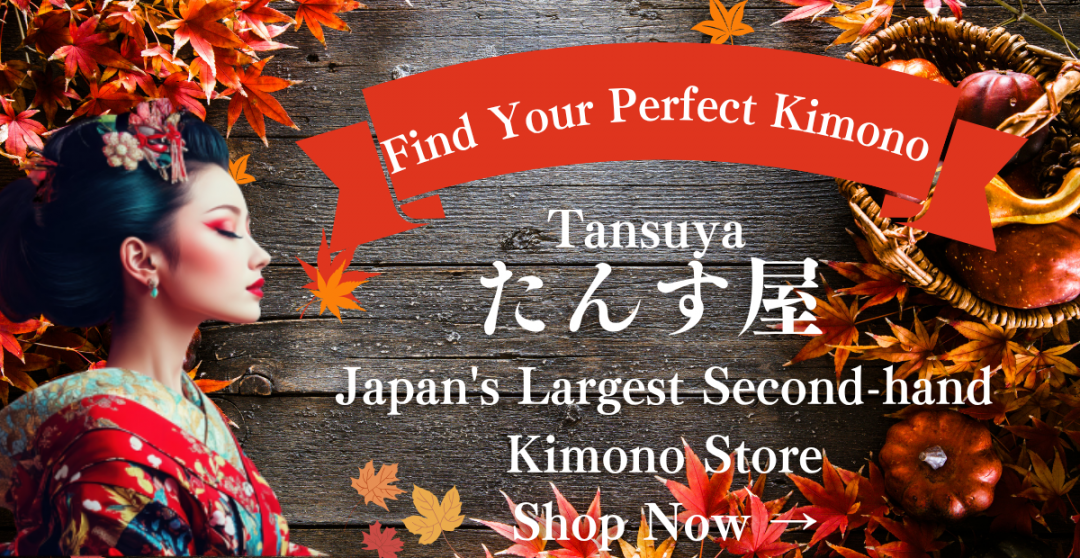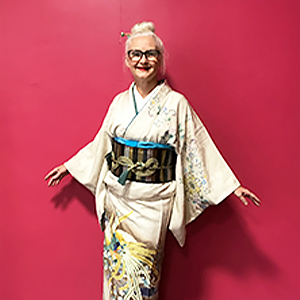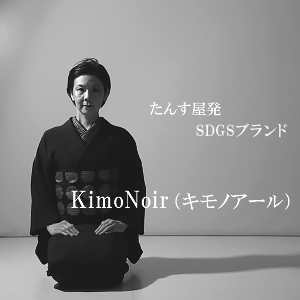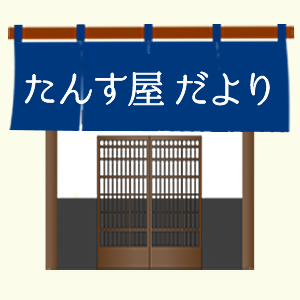2025年04月07日
Experience Kimono: A Unique Step into Japan’s Culture
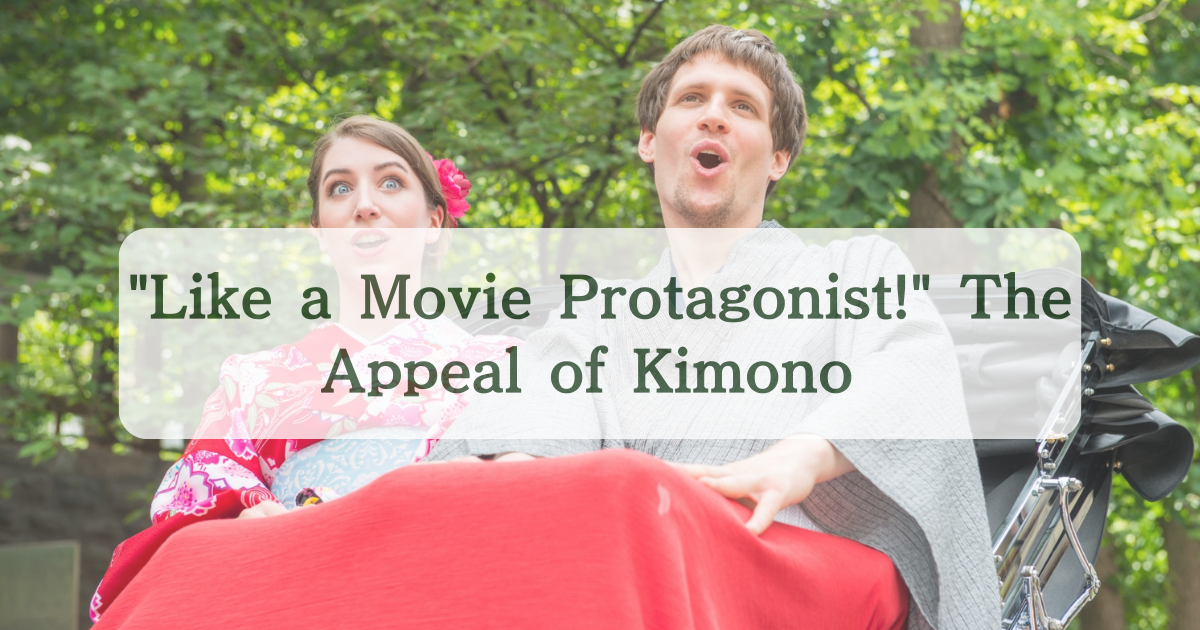
Have you ever dreamed of stepping into the world of your favorite Japanese movie or anime? Of walking through ancient temple grounds dressed in vibrant silk, turning heads as you glide through historic streets? This isn’t just fantasy—it’s the real experience awaiting you when you try on a kimono or yukata during your visit to Japan.
2025/10/02
Contents
- 1. Why Kimono Experiences Are the Highlight of Japan Travel
- 2. Kimono Experience Destinations: Where to Live the Dream
- 3. Practical Guide: Making the Most of Your Kimono Experience
- 4. Beyond the Experience: Bringing Japan Home
- 5. A Transformative Cultural Encounter
1. Why Kimono Experiences Are the Highlight of Japan Travel
The kimono or yukata —Japan’s traditional garment with a history spanning over a thousand years—offers more than just a photo opportunity. It’s a portal into Japanese aesthetics, culture, and a completely different way of experiencing the country’s most beautiful locations.
Foreign visitors consistently rank kimono or yukata experiences among their most memorable activities in Japan. Here’s why you shouldn’t miss this opportunity:
Transform into a Living Work of Art
When you don a kimono, you’re wearing nothing less than wearable art:
- Breathtaking Craftsmanship: Each kimono represents hours of meticulous work by skilled artisans. The intricate patterns aren’t merely printed—they’re often hand-dyed, embroidered, or painted directly onto silk.
- Symbolic Designs: Every element of a kimono tells a story. Cherry blossoms represent the ephemeral beauty of life, cranes symbolize longevity, and wave patterns connect you to Japan’s island heritage. Wearing these symbols creates a deeper connection to Japanese cultural values.
- Seasonal Expression: Kimono designs change with the seasons—light fabrics with water motifs for summer, warm autumn leaves and chrysanthemums for fall, plum blossoms against snow patterns for winter, and cherry blossoms for spring. Your kimono can be perfectly matched to the time of your visit.
Experience Japanese Culture Through Your Body
The moment you put on a kimono, something remarkable happens:
- Moving with Grace: The structure of the kimono naturally guides your posture and movement. You’ll find yourself walking with smaller steps, moving your arms differently, and becoming more aware of your body in space—experiencing firsthand the physical foundation of Japanese aesthetics.
- Mindful Presence: The process of wearing a kimono encourages mindfulness—each movement becomes more deliberate and considered. Many visitors report feeling an unexpected sense of calm and presence while wearing kimono.
- Cultural Understanding: There’s no better way to understand certain aspects of Japanese culture—like why traditional rooms have low tables, why bowing developed as it did, or why certain gestures appear in traditional dance—than experiencing how your movement changes in a kimono.
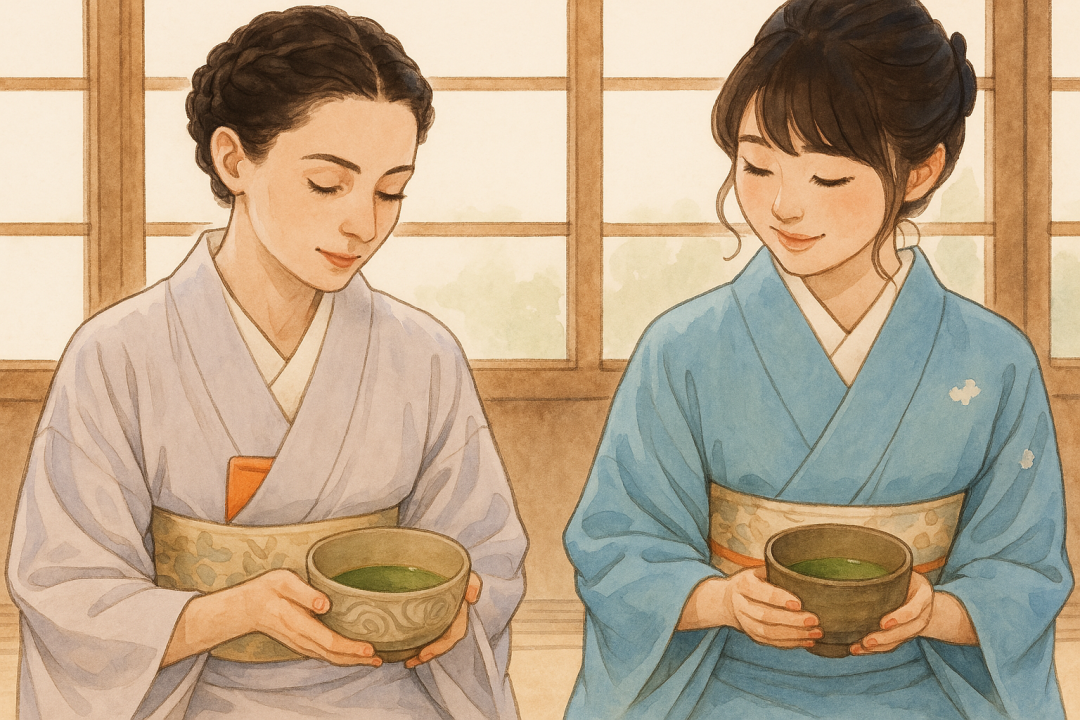
Become the Protagonist of Your Japan Journey
For fans of Japanese cinema, anime, or period dramas, wearing a kimono delivers a particularly magical experience:

- Step Into Your Favorite Stories: Whether you’ve been captivated by the historical worlds of “The Last Samurai,” the supernatural landscapes of “Spirited Away,” or the sword-wielding heroes of “Demon Slayer,” wearing a kimono lets you physically step into these narrative worlds.
- Cinematic Photography: Local photographers know exactly how to capture you against temples, gardens, and historic streets to create images that look straight out of a film set. Your social media will never look better!
- Create Lasting Memories: Former visitors consistently report that their kimono experiences remain among their most vivid and cherished memories of Japan, even years later.
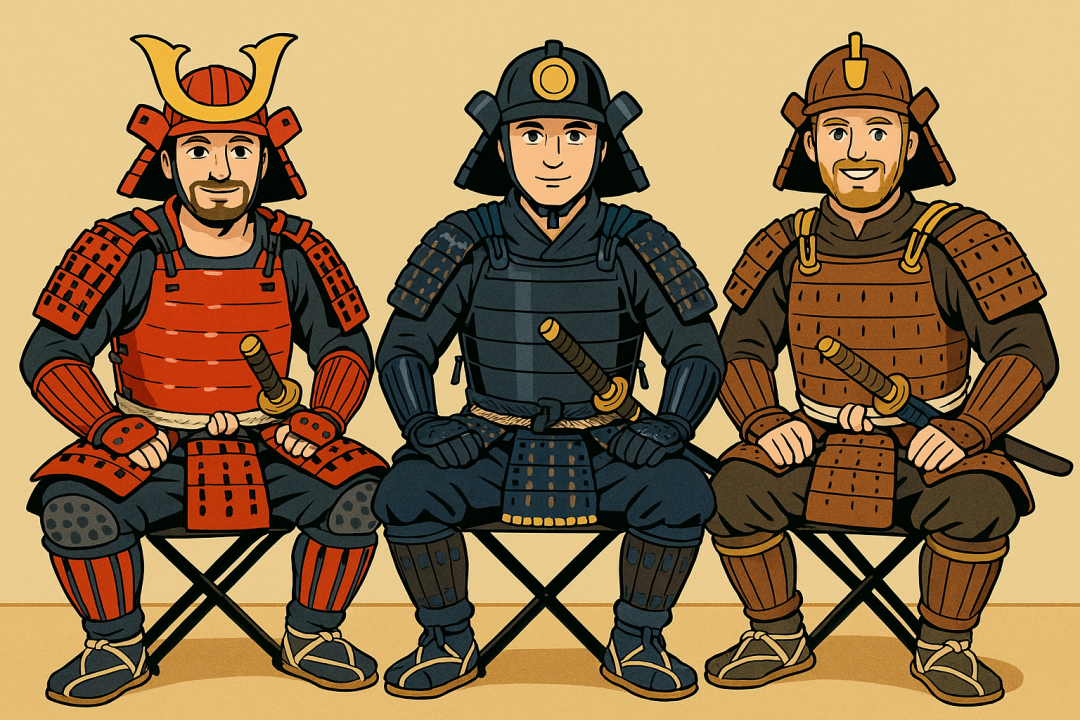
2. Kimono Experience Destinations: Where to Live the Dream
Japan offers numerous places to experience kimono, but these three destinations provide the perfect combination of stunning backdrops, quality rental services, and authentic cultural immersion:
2-1 Kyoto: The Ultimate Kimono City
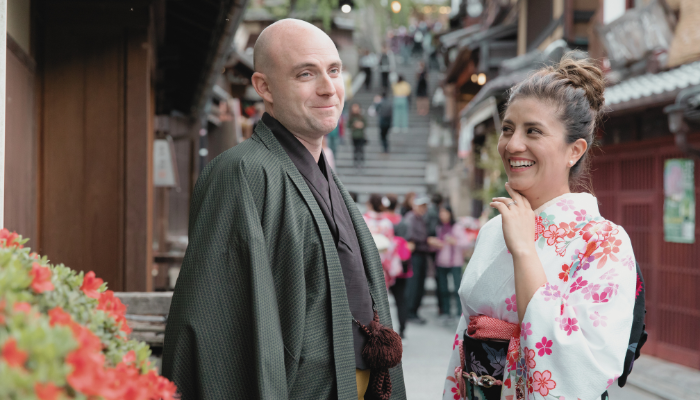
As Japan’s former imperial capital for over a thousand years, Kyoto offers the most sublime kimono experience:
- Perfect Backdrops: Wear a kimono while walking through the bamboo groves of Arashiyama, along the philosopher’s path, or beneath the thousands of vermilion gates at Fushimi Inari Shrine—creating perfect harmony between your attire and surroundings.
- Premium Services: Kyoto’s rental shops offer the highest quality kimono with staff who understand foreign body types and preferences. Many provide English-speaking assistants who can explain the symbolism of your chosen design.
- Extended Cultural Experiences: Combine your kimono rental with a tea ceremony, maiko (apprentice geisha) meeting, or traditional kaiseki meal for a full immersion into traditional Japanese aesthetics.
Insider Tip: Visit during spring cherry blossom season or fall foliage for the most spectacular photos, but book well in advance as this is peak season.
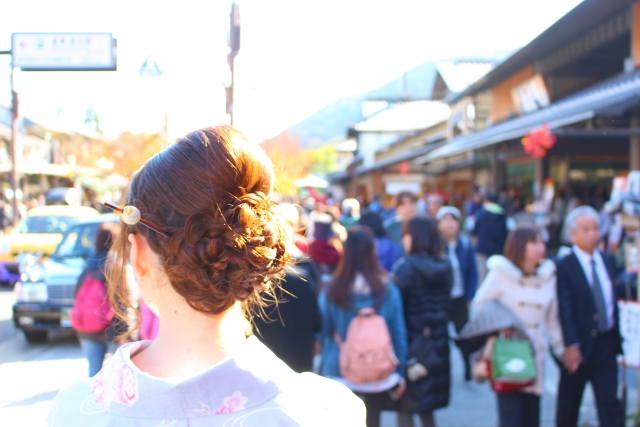
2-2 Asakusa, Tokyo: Accessible Elegance in the Capital
If you’re based in Tokyo, Asakusa offers the perfect kimono experience:
- Convenient Location: Just a short subway ride from central Tokyo hotels, Asakusa allows you to experience kimono without dedicating an entire day to travel.
- Iconic Backdrops: The massive red lantern of Kaminarimon Gate, traditional shopping streets of Nakamise, and the ancient Sensoji Temple create distinctly “Japanese” settings for your photos.
- Combine with Modern Tokyo: Experience the fascinating contrast of traditional kimono against modern Tokyo’s skyscrapers and neon lights—a unique visual juxtaposition that captures Japan’s blend of tradition and innovation.
Insider Tip: Add a rickshaw ride to your experience—the drivers are skilled photographers who know the best angles and hidden spots for photos.
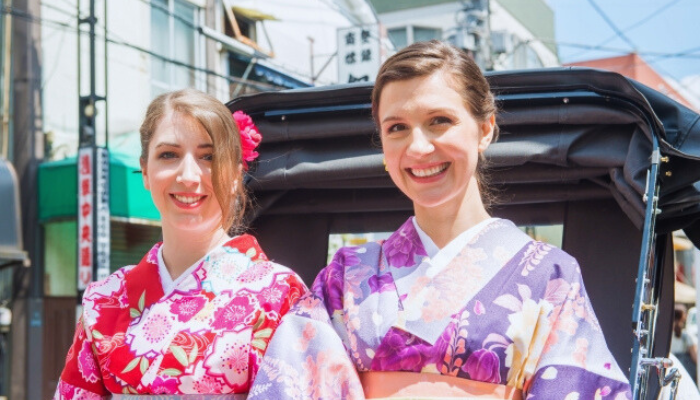
2-3 Kanazawa: The Hidden Gem for Authentic Experiences
For those seeking a less crowded, more authentic experience:
- Preserved Edo-Period Districts: Higashi Chaya and other historic districts remain almost unchanged since the samurai era, providing a genuine historic atmosphere.
- Kaga Yuzen Kimono: Try the local Kaga Yuzen style of kimono featuring distinctive designs with gold leaf accents—a specialty of this region famous for gold craftsmanship.
- Unhurried Experience: With fewer tourists than Kyoto, you can take your time and truly savor the experience without feeling rushed or crowded.
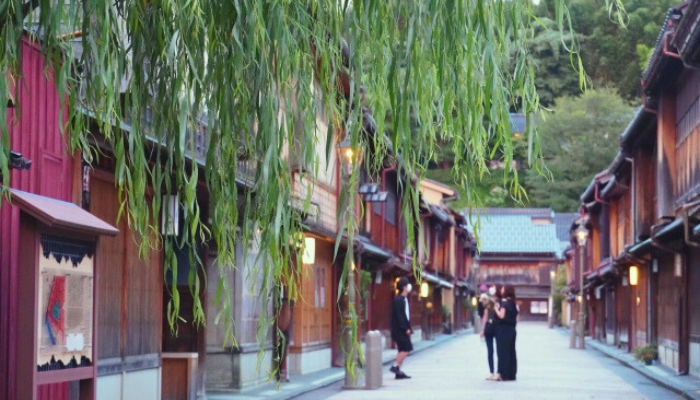
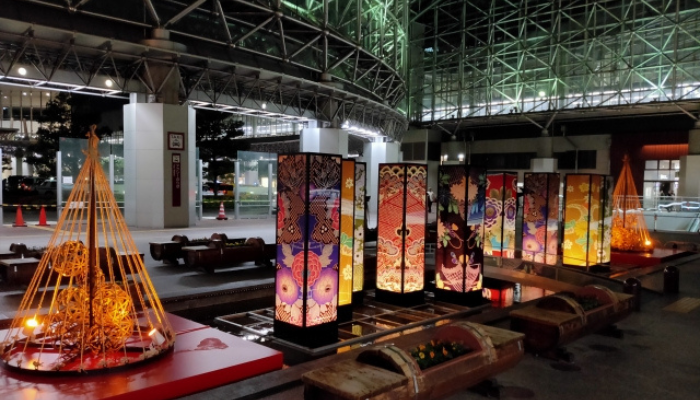
Insider Tip: Visit Kenrokuen Garden in kimono, one of Japan’s three most beautiful gardens, for spectacular photos in any season.
3. Practical Guide: Making the Most of Your Kimono Experience
3-1 Choosing the Right Rental Shop
Look for these features when selecting a rental service:
- English Support: Staff who can communicate clearly will enhance your experience significantly.
- Full-Service Options: The best shops offer complete packages including undergarments, shoes, bags, hair styling, and accessories.
- Photography Services: Some premium shops include professional photography sessions.
- Online Reservations: Book in advance to ensure availability, especially during peak seasons.
- Kimono Rental Pricing Guide: The average price range for kimono rental services for foreign visitors is typically around 3,000 to 8,000 yen, similar to standard kimono rentals.
Prices vary depending on the plan, with factors such as hair styling services and kimono types affecting the cost.
There are also regional price differences, with tourist destinations like Kyoto and Tokyo trending slightly higher at 5,000 to 10,000 yen. In contrast, provincial cities may offer more affordable rates ranging from 2,500 to 7,000 yen.
Additionally, during peak seasons (such as cherry blossom season or Golden Week holidays), prices are often 1,000 to 2,000 yen higher than usual.
3-2 Thinking of Buying a Kimono?
Renting a kimono for a day is fun, but sometimes it just isn’t enough—you fall in love with it and want one of your own. Buying a kimono can be a beautiful way to connect with Japanese culture, but there are a few things you should know before you pull out your wallet.
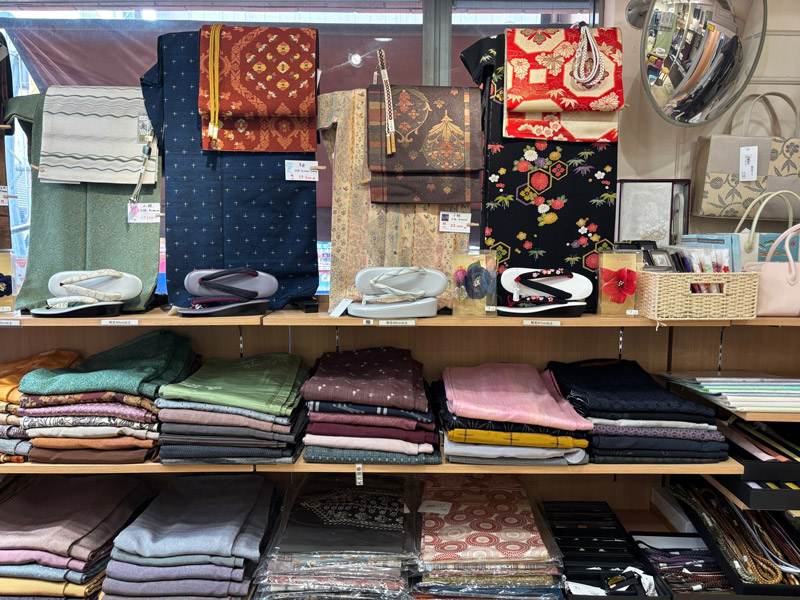
How to Find a Good Kimono Shop
- Look for Long-Standing Stores: Shops with a solid history and local customers usually have better quality stuff than touristy spots.
- Helpful Staff: Even if their English isn’t perfect, good shops have staff who really know kimono and can guide you through styles, fabrics, and what’s appropriate for different occasions.
- Prices Should Be Clear: Honest shops show clear pricing. If things seem vague or “negotiable,” take that as a red flag.
- Official Recognition: Some places are certified or part of kimono trade groups—another good sign.
- Fitting Options: Traditional kimono sizes are pretty standard, but good shops can often help adjust or tailor it to fit your body better.
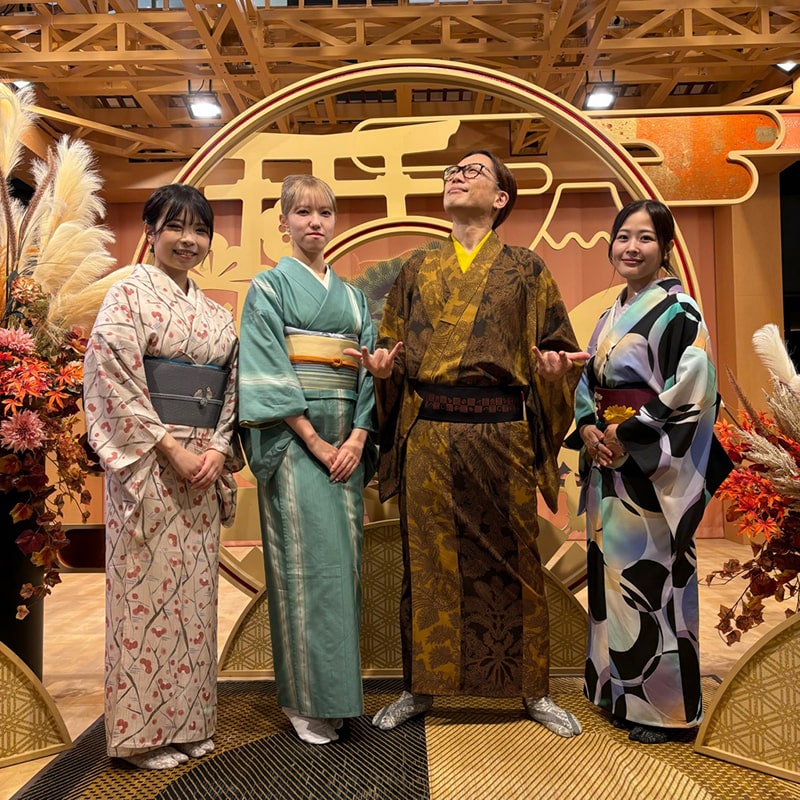
What Affects the Price?
- New vs. Vintage: A brand-new silk kimono can be super pricey (like, thousands of dollars), but secondhand ones can go for $50–1000. Casual yukata are much cheaper.
- Material Makes a Difference: Silk is the most expensive. Polyester and cotton-blend ones are more budget-friendly.
- How It’s Made: Hand-dyed styles (like yuzen or shibori) are beautiful but cost more than printed ones.
- Seasonal Styles: Summer kimono are usually lighter—and cheaper—than the thicker ones for winter.
- Don’t Forget the Accessories: A full outfit means you’ll also need an obi (belt), underlayers, and a few extras. Plan for that in your budget.
How to Tell if It’s Good Quality
- Check the Stitching: Seams should be neat and solid. Even hand-sewn ones should look clean.
- Look at the Fabric: Hold it up to the light to spot any damage, fading, or worn areas.
- Pattern Matching: Good kimono have patterns that line up at the seams—it’s a mark of quality.
- Lining and Smells: Check the inside fabric and make sure there’s no musty or moldy smell.
- Bonus Points: Some higher-end kimono come with a certificate showing what materials or techniques were used.
Where You Can Shop
- Big Department Stores: Places like Takashimaya Isetan or Mitsukoshi have great selection and English-speaking staff, but they’re not cheap.
- Specialty Kimono Shops: Areas like Kyoto’s Nishijin or Tokyo’s Kagurazaka Asakusa and Ginza are famous for having expert shops.
- Vintage Markets: Antique spots like Kyoto’s Teramachi or Tokyo’s Oedo Antique Market are great for one-of-a-kind finds.
- Used Kimono Stores: Chains Tansuya(たんす屋) have stylish secondhand pieces.
- Online Stores: Sites like Tansuya-online ship overseas by “Buyee” and have great photos.

Mega Tansuya Haneda Store is a specialty shop for recycled kimonos. Experience Japan’s wonderful traditional ethnic attire, the kimono, at a location just minutes from Haneda Airport International Terminal.
ーad
A Few Practical Things to Know
- Sizing Can Be Tricky: Traditional kimono fabric is narrow, so if you’re taller or broader, definitely ask the shop for advice.
- Packing It Home: Kimono fold up nicely, but they still need careful packing. Some shops can show you how or give you a special bag.
- Customs Stuff: If your kimono is expensive or made of silk, you might need to declare it at customs—save the receipt just in case.
- Cleaning & Storage: Don’t throw it in the washing machine! Most kimono need pro cleaning. Ask how to take care of it.
- Why Are You Buying It?: Planning to wear it, display it, or just collect it? That can help guide what kind you should choose.
Tips to Make a Smart Purchase
- No Need to Rush: Take your time—it’s not an impulse buy.
- Ask for the Story: If it’s vintage or handmade, see if the shop can tell you more about its background.
- Learn a Few Words: Knowing basic kimono terms can help, even if you’re just browsing.
- Think About Aftercare: Can you get it cleaned or cared for once you’re back home?
- Build a Connection: If you find a great seller, stay in touch—they might help you find your next favorite piece.
Buying a kimono is more than just shopping—it’s about bringing a little piece of Japan into your life. Whether you wear it on special days or display it like art, a well-chosen kimono is something to treasure for years to come.
3-3 Kimono Types to Consider
Different styles offer unique experiences:
- Furisode: The most formal and dramatic kimono with long, flowing sleeves—perfect for those seeking the most photogenic option.
- Homongi: Elegant and suitable for mature visitors, with patterns that flow across seams.
- Yukata: Lightweight summer kimono, more comfortable in hot weather and easier to wear.
- Hakama: Consider this divided skirt-like garment worn over a kimono for a samurai or graduation style.
- Men’s Kimono: More subdued in color but equally elegant, offering a dignified, refined appearance.
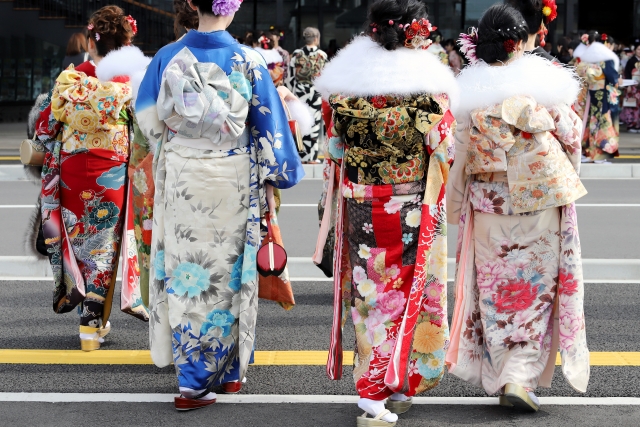
3-4 Planning Your Day
For the best experience:
- Allow Time: Set aside at least 30-45 minutes for dressing, and plan for a half or full day in kimono.
- Comfort Considerations: Wear easily removable clothes to the rental shop, and choose comfortable underwear.
- Weather Awareness: Most shops offer seasonal options appropriate for the weather.
- Dining Plans: Consider restaurants with tatami seating for an authentic experience, but be aware that some fine dining establishments might have kimono-specific etiquette.
4. Beyond the Experience: Bringing Japan Home
After your kimono experience, you might want a lasting connection to this art form:
- Affordable Souvenirs: Look for yukata (casual summer kimono), kimono-inspired fashion, or textile pieces that capture the aesthetic.
- Traditional Accessories: Furoshiki wrapping cloths, fans, or hair ornaments make practical souvenirs that reflect kimono culture.
- Support Preservation: Consider contributing to organizations working to preserve traditional textile arts in Japan.
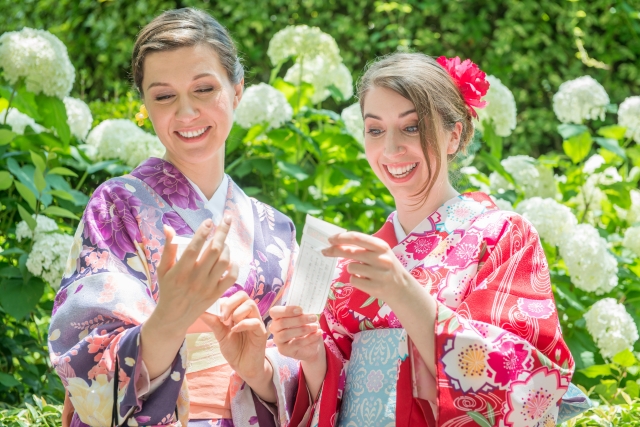
5. A Transformative Cultural Encounter
Wearing a kimono isn’t just about donning a beautiful garment—it’s about experiencing Japan through a completely different lens. As you adjust your movements to accommodate the silk, as you feel the admiring glances of locals appreciating your interest in their culture, and as you see yourself transformed in reflections and photographs, you’ll understand why this experience ranks among the most treasured memories for visitors to Japan.
Unlike passive sightseeing, a kimono experience engages all your senses and transforms you from observer to participant in Japanese cultural tradition. It’s not just about looking the part—it’s about feeling, even briefly, what it means to embody centuries of refined aesthetic tradition.
Don’t just visit Japan—become part of its living cultural tapestry, one elegant step at a time.
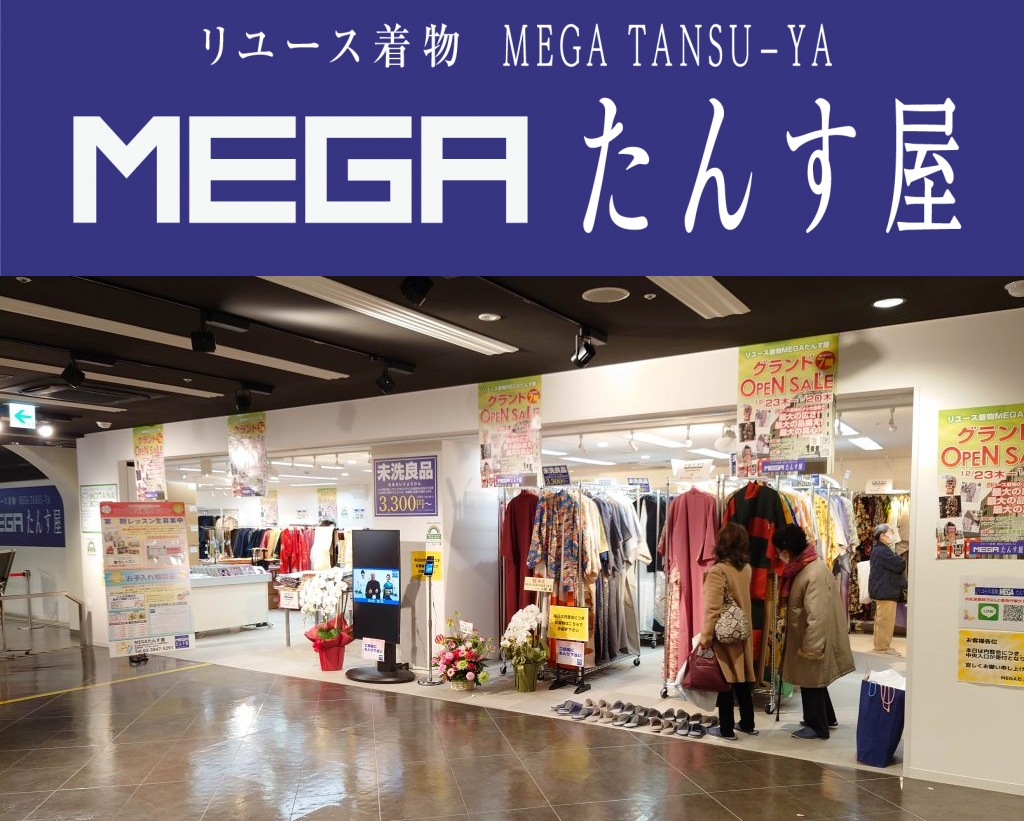
Mega Tansuya Asakusa: Japan’s Ultimate Kimono Treasure Hunt
Discover the joy of authentic Japanese kimono without the luxury price tag at Mega Tansuya Asakusa, Tokyo’s largest secondhand kimono specialty store.
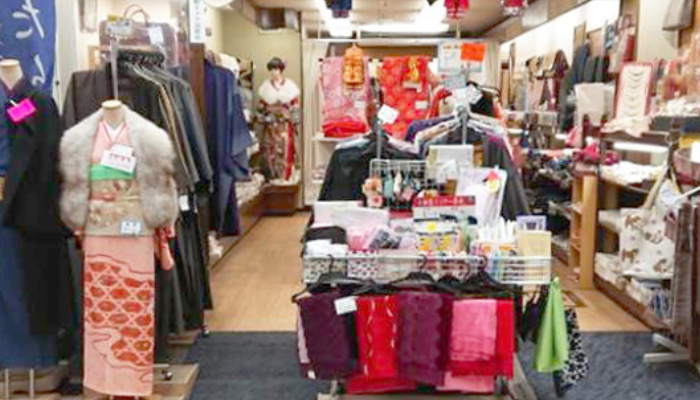
Discover Tansuya Nakamise Store: Vintage Kimono Treasure in Asakusa
Hidden Gem for Authentic Japanese Kimono
Tansuya Nakayanise Store, specializing in high-quality pre-owned kimonos at affordable prices!
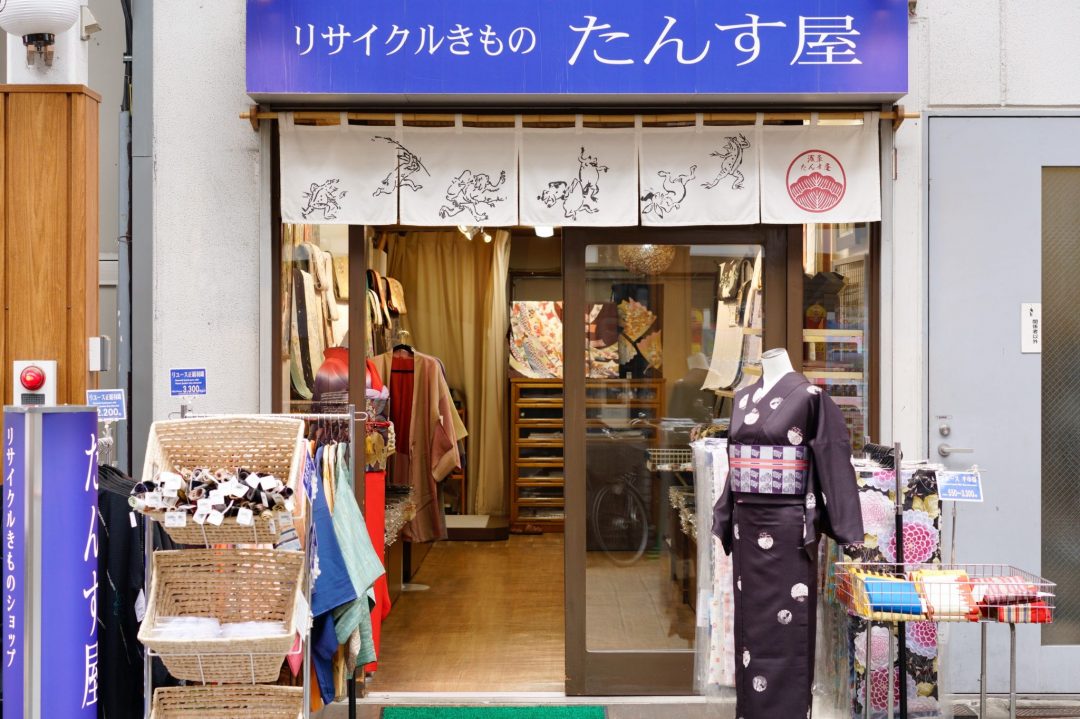
Discover Tansuya Asakusa Store: Asakusa’s Premier Vintage Kimono Shop
Just one minute’s walk from Asakusa Station (Exit 8 on Tokyo Metro Ginza Line or Tobu Skytree Line), our distinctive blue signboard and white noren curtain with playful Choju-giga animal motifs welcome you to a world of authentic Japanese kimono treasures.

Tansuya Asakusa Kokaidou-mae: Your Gateway to Authentic Kimono Culture
Located directly across from the famous Asakusa Kokaidou (Asakusa Public Hall), home to New Year’s Kabuki performances and Coming-of-Age ceremonies, our shop sits on the vibrant “Orange Street” (Orange-dori), a bustling area filled with kimono heritage and visiting tourists. Finding us is simple – just search for “Asakusa Kokaidou,” “Orange Street,” or “Tansuya”!


